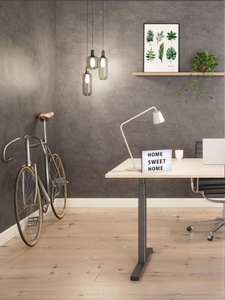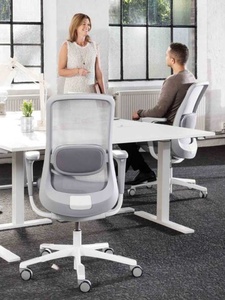Research Review: Are there health benefits to using sit-stand desks?
Office based workers are sitting longer than ever before and sedentary behaviour is having a huge negative impact on our health. There is a growing body of research showing that a sedentary lifestyle is detrimental to our long-term health. In the past, it was thought that if you get aerobic exercise at least a few times a week and watch your diet, you’ll offset a sedentary lifestyle. However, according to James Kennedy, senior ergonomic consultant with KOS Ergonomics “The research shows exercise alone is not the perfect antidote for prolonged sitting and there is increasing evidence that prolonged sedentary behaviour has a long lasting negative impact to our health and cannot be fully compensated by short periods of moderate to vigorous exercise”. Health professionals and large companies are recognising this and are now looking to create more active work environments for employees. Kennedy noted “Companies, now understand that the human body is in conflict with technology, in a sense. Technology is eliminating the need for whole body movement completely in some roles. The human body needs a consistent moderate level of movements, for brain to perform optimally, for the body to function and recover adequately and while.”
Ireland is playing catch up
Ergonomists and health care professionals have recognised the body’s need for postural changes for many years. Kennedy states “I have always encouraged flexible workstation designs that support an easy transition from sitting to standing as one solution to the sedentary office environment. Sit-stand working has been the norm in Scandinavia since the 90’s and it’s only really in the last two years that I’ve seen it become the norm in the modern Irish workplace, which is great!”. As a company, KOS Ergonomics have been promoting active working and postural variation since its inception and introduced sit-stand desks to Ireland originally over 17 years ago. Kennedy notes says “When we first introduced them to Ireland they were, novel and more expensive and only really bought by people with back injuries, the very tall, very small individuals and the very health conscious. However, in 2014, things seemed to change overnight and the increase in demand was huge. “It has been great for us as a company, as with the increase in demand, our pricing has come down significantly also and for a single Danish made sit-stand desks for €699, where previously prices that low was unheard of”
Why the change to sit-stand working - Health Risks of sitting:
Kennedy says “I believe this change has a lot to do people in the ergonomics and health community highlighting the health impact of sedentary behaviour but it was also majorly helped by health campaigns in the UK that were promoting active working and sit-stand workstations”. In the ergonomics field, the focus has been traditionally on reducing the negative musculoskeletal impacts of prolonged sedentary work but recent research has shown there are far more risks than just musculoskeletal. It was reported in the British Journal of Sports Medicine that “prolonged bouts of sitting and lack of whole body muscular movement as being strongly associated with obesity, diabetes, heart disease, cancer, and an overall higher risk of death, irrespective of whether moderate to vigorous exercise is undertaken.”
Musculoskeletal Disorders
While MSDs have traditionally been associated with physically strenuous occupations, there is increasing evidence that sedentary office work and other constrained sitting or standing postures are associated with a high incidence of MSDs, in particular, back complaints.
Prolonged sitting increases the deformative force on the discs of the spine due the loss of lumbar lordosis where the load on the discs in the lumbar spine increases significantly. Prolonged sitting is regularly associated with a high incidence of back complaints, as well as increased muscle loading of the neck and shoulder muscles when sitting with the forearms unsupported
Standing requires more effort compared to sitting. While standing, you tense your leg muscles, and engage the muscles of your back and shoulders; while often shifting from one foot to another. All of this requires energy usage. Prolonged standing increases the load on the lower limbs significantly and requires constant tension of the core to maintain an upright posture and can result in more musculoskeletal discomfort than sitting, particularly in the lower limbs.
There is no perfect position that it is recommended for the body to hold. Research shows that static standing is not the answer, nor is static sitting recommended. Each position has its positives and negatives. The research shows there are risk factors for both constrained standing and constrained sitting; it shows that varying work postures may be preferable. Changing between multiple postures allows for increased rest intervals for upper and lower limbs, and reduces the potential risks associated with the development of musculoskeletal disorders.
Increased Risk of Obesity
Research from James Levine, an endocrinologist at the Mayo Clinic, investigated why some office based workers put on extra weight, while others didn’t. The researcher standardised participants’ diet and eating habits and found that some participants gained weight, while others remained slim. Participants every subtle movement was tracked using sensors and the study found the participants who weren’t gaining weight were standing up or walking around for an average of 2.25 hours per day, even though they were all working in similar sedentary, desk based roles.
Kennedy advises “our bodies are designed for movement and require it. Our increasing reliance on technology, results in a lot of the tasks we do day to day require no movement and this isn’t beneficial for our physical or mental health. We need to look for opportunities to move regularly throughout the day and not doing so is linked to increasing the risk of obesity. A study undertaking in the University of Chester found that on average standing burns 50 calories more per hour than sitting.
Increased Risk of Type 2 Diabetes and Other Metabolic Problems
Evidence from Levine’s work and similar studies suggest prolonged sitting results in the cells in the body becoming less responsive to insulin. Sedentary behaviour also saw a sharp reduction in the activity of the enzyme lipoprotein lipase, which breaks down blood fats and helps the conversion to fuel for the muscles.
Studies have found that sitting for extended periods of time is correlated with reduced effectiveness in regulating levels of glucose in the blood stream, part of a condition known as metabolic syndrome that dramatically increases the chance of type 2 diabetes.
Increased Risk of Cardiovascular Disease
A study carried out by Levine and his colleagues also found that adults who spend four or more hours per day sitting have a 125 percent increased risk of health problems, such as heart attacks, chest pain and other problems related to cardiovascular disease.
Increased Risk of Cancer
There is evidence that cancers, in particular, breast and colon cancer appear to be influenced by a lack of physical activity also. In 2011, a study by Christine Friedenreich, an epidemiologist at Alberta Health Services-Cancer Care in Canada found that sedentary behaviour could be the cause of 49,000 cases of breast cancer and 43,000 cases of colon cancer per year in America. Her study also saw a correlation with excessive sitting and a significant amount of other cancers lung cancer (37,200 cases), prostate cancer (30,600 cases), endometrial cancer (12,000 cases) and ovarian cancer (1,800 cases).
Standing is not the answer!
This is not to say, standing all day is the answer. The term “standing desk” is confusing to people looking to invest in sit-stand desk. “Standing desk” would indicate, that the correct behaviour is to stand for as long as possible which is not the case. Research by Peter Smith of Institute of Work and Health, Canada was published in the American Journal of Epidemiology in 2017, found occupations involving predominantly standing were associated with an approximately 2-fold risk of heart disease compared with occupations involving predominantly sitting. Cardiovascular risk associated with occupations that involve combinations of sitting, standing, and walking differed for men and women. Kennedy recommends that “variety is your best friend when you work in a sedentary role and I always advise clients, not to focus on sitting or standing only but your next position is your best position.”
Change culture, not only the environment or equipment
The Irish workplace has not seen such a drastic change to the work environment since the PC became mainstream. Sit-stand desks are new to most people in Ireland and companies can make the mistake of assuming that they all perform the same and that they can fit exactly into a workspace designed for a fixed desk and that’s not always true. Kennedy mentions that “On a few occasions, I’ve been brought in after companies have just purchased sit-stand desks and have got it terribly wrong. There are a lot more factors to consider than with a fixed desk; privacy, distraction of colleagues, accommodating the different height ranges, load capacity, noise, stability, cabling, acoustic and lighting issues, When companies choose sit-stand desks as the standard for all employees, clients will always ask our ergonomic consultants to consult with their architects/designers, facilities department and health and safety departments to advise on what specification, layouts and configuration is most suitable for the range of employees, tasks and environment.
When a company is converted from fixed desks to sit-stand desks, it always goes hand in hand with an education program. You can provide employees with ability to incorporate more movement and postural variation into their working day but unless you educate them on the benefits and health impacts of doing so, it will not be as successful as it should be. Forming the habits is crucial in creating a more active work environment and with any successful cultural change, it needs to go hand in hand with an education.
Ease of use is paramount
Humans by nature are lazy and will avoid things that are complicated and difficult. That is why if the sit-stand desk is difficult to adjust, people are unlikely to change postures at all, let alone frequently, as is recommend. In the first few years, when we provided sit-stand desks, we had systems that were adjusted using a manual hand cranks. After analysing usage over many years in the work environment, we found that they were not being utilised fully, as the users found it difficult and time consuming to make the necessary adjustments, and users therefore typically didn’t adjust it regularly or didn’t adjust it at all. Workspaces need to be designed to make it as easy as possible to do the correct option otherwise it won’t be done. The most effective adjustment systems currently on the market are those with electric motors.
Recommendations for selecting the correct sit-stand desk.
- Choose electric motor desks over crank systems or counter balance systems. From the many tested over the years and found Linak to be the best
- If going with an electric sit-stand desk, ensure 110kg minimum dynamic load capacity. Light weight load capacity motors are far less reliable and often have a shorter life.
- Test the stability of the desk when it is at its highest, this is where it is least stable and can cause movement in parts which is most likely cause of breakage.
- Anti-collision sensors are recommended to reduce the risk of injury or damage.
- Ensure a suitable height range to accommodate potentially tall and short employees. The greater the height range the better. Ensure sit-stand desk has a minimum height adjustment range of 650mm. as required under BS EN 527-1: 2011.
- Ensure to source from a reputable supplier. All suppliers of sit-stand desks are required under law to be registered and comply with WEEE Waste Management regulations
- If you are introducing a number of sit-stand desks into the space, consult with your ergonomics team or an experienced ergonomic consultant for advice on set up and layouts.
Best practice for sit-stand desk usage:
- If you are introducing them to replace fixed height desk, this must be done in conjunction with an educational campaign.
- Variation is the key and regular postural change. The more frequent the change the better. Ideally there should be two postural changes per hour. Initially try to stand for at least 10 minutes per hour and try to increase this to 20-25 minutes per hour. Public Health England recommend desk based employees should aim to initially progress towards accumulating 2 hours per day of standing and light activity during working hours. This should eventually increase to a total accumulation of 4 hours per day or half their working day.
- Simply standing is insufficient. Movement is important to get blood circulation through the muscles. Encourage employees to look for reasons for short breaks away from the desk at least once an hour. The desk should only be one element of the active work environment.
- Raise desk to height where shoulders are relaxed and arms are at right angles, level with the desk
- Ensure enough slack in the cables and suitable cable management to reduce the risk of trip hazards.
Kennedy predicts that “in the next 5-10 years all large companies in Ireland will be using sit-stand desks as standard. What is happening now in Ireland is very comparable to what happened in Scandinavia in the 90’s, where physiotherapists, ergonomists and other occupational health professionals are really driving this forward. Technology is evolving at a much faster rate than the human body can adapt. As humans, we need to take control of our own health and not let technology eliminate movement from our daily lives. In most office jobs, the employee is most productive at their desk, when they have the ability to change from sitting to standing effortlessly without interrupting their work. Maximum oxygen is reaching the brain and productivity is at its highest. Employee health is protected and absenteeism is substantially reduced. The return on investment period is very short so most organisations do not see the cost as a barrier. The solution, isn’t to sit all day in work and then head for a run or to the gym afterward, because evidence suggests that the negative impact of prolonged sitting cannot be countered by brief bouts of strenuous exercise. The solution is to incorporate variation into our day, standing, walking and other forms of light activity.
Sit or stand? – No, sit, stand and move!
Writer Profile
James Kennedy, Senior Ergonomic Consultant, KOS Ergonomic Solutions.
James works for KOS Ergonomics, Ireland’s leading ergonomic solutions and equipment provider working with Ireland and UK’s leading companies. He studied occupational ergonomics and occupational health and safety and he works with workplace professionals advising on ergonomic design and helping them to determine the most appropriate ergonomic solutions and equipment to improve their work environment.















